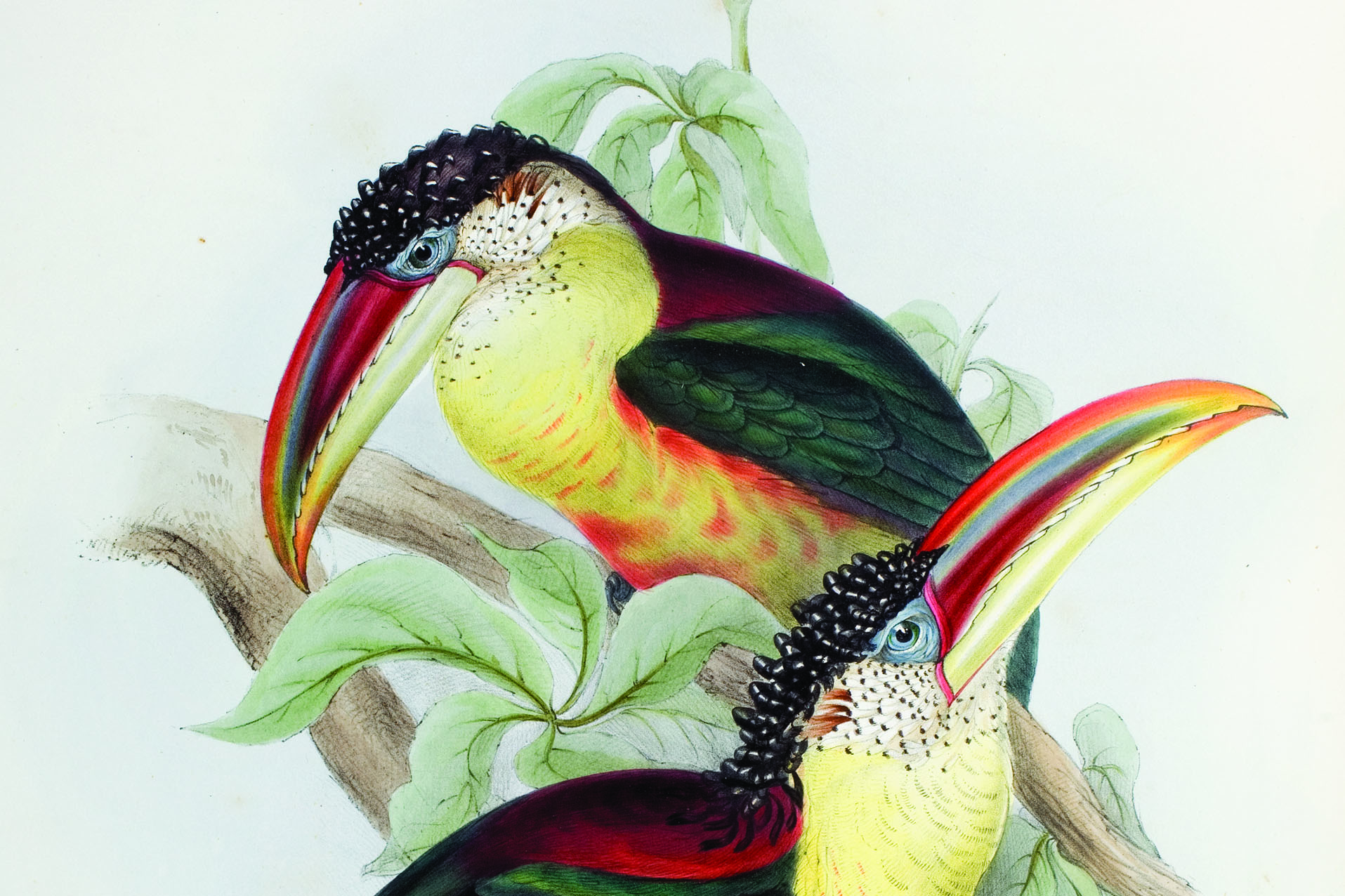
About Aves
The online exhibition Aves: A Survey of the Literature of Neotropical Ornithology was adapted from the exhibition catalogue of the same title, written by Tom Taylor, with contributions by Michael L. Taylor, and published by LSU Libraries in 2011. All text on the online exhibition reflects text printed in the catalogue. Aves debuted online in August 2012.
Introduction
Birds and books have a way of stirring people’s passions. The combination of the two has led to the creation of some of the most treasured and sought-after books in existence. This survey of four centuries of works about ornithology in the Neotropics – Mexico, Central America, South America, and the Caribbean – brings together the stories of men and women whose enthusiasm for birds resulted in the creation of many books, some beautiful, some useful, some both. How did this survey come to be? Why here, why now? The genesis of Aves, similar to the works it surveys, lies in the enthusiasm of three particular men for birds and books.
The first is Edward Avery McIlhenny (1872-1949), scion of the prominent Louisiana family that, since 1868, has produced the world-famous hot pepper sauce Tabasco®. Born March 29, 1872, “Ned” McIlhenny showed an early interest in the natural world. “Birds, plants, shooting, and fishing . . . For all my life these subjects . . . interested me more than any others” (Bernard 2007, 99). He dropped out of Lehigh University in 1894 in order to serve as the ornithologist on an Arctic expedition led by Frederick A. Cook. The expedition was short-lived. Its members departed from New York aboard the steam freighter Miranda on July 15 of that year, but the ship struck a reef off the Greenland coast and sank on August 7 (Mills 2003, vol. 1, 155).
Disappointed in his bid for Arctic adventure, McIlhenny returned to Louisiana that fall. Living on the family estate on Avery Island in the Atchafalaya Basin, he was struck by the great decline in the number of snowy egrets that nested in the surrounding swamplands. Millions of the birds were being slaughtered for their plumes, which were so prized for ladies’ hats that a pound of egret feathers was, at the time, worth more than a pound of gold (Bales 2010, 52).
A decisive man with considerable organizational skills, McIlhenny took action, first setting up a private refuge on the family estate and subsequently working to secure thousands of acres of south Louisiana marshland as federally protected wildlife refuges. While successfully advocating for bird conservation in the United States, McIlhenny was also running the family company that made Tabasco®, as well as breeding and selling varieties of azaleas, iris, camellias, bamboo, and other plants in Jungle Gardens, the 170-acre botanical garden and bird sanctuary on Avery Island. He authored four books, oversaw the publication of several translations, and wrote a number of articles on natural history topics. In addition, he collected books, especially those about birds and plants, many of which reflected his penchant for exploration and discovery.
When Ned McIlhenny died, in 1949, his natural history books were passed on to his nephew, the second man whose enthusiasm has been key to the creation of Aves. John Stauffer McIlhenny shared his uncle’s bibliophilia, as well as his commitment to the cause of wildlife conservation. After enjoying and adding to the collection for more than two decades, “Mr. Jack” decided that his treasures should be shared. He donated the collection to the LSU Libraries in 1971 and provided financial support for its continued development until his death in 1997.
Today, the collection includes more than three thousand titles. Among the more notable works in the collection are the elephant folio edition of John James Audubon’s Birds of America, Mark Catesby’s The Natural History of Carolina, Edward Lear’s Illustrations of the Family of Psittacidae, or Parrots, and Banks’ Florilegium. With particular strengths in New World botanical and ornithological illustration, the McIlhenny Collection is well suited to support an exhibition and book focused on the history of Neotropical ornithology. Moreover, LSU is home to another collection that offers resources to explore current work in the Neotropics. The LSU Museum of Natural Science’s ornithologists have for decades concentrated on the Neotropics, conducting ornithological field research in South America every year since 1962 and amassing one of the larger collections in the world of bird specimens from the region.
With those resources at hand, the stage was set for the enthusiasm of a third man, Tom Taylor, to result in the book you hold and the accompanying exhibition, mounted in Hill Memorial Library on the LSU campus in Baton Rouge, May 23 – September 10, 2011. Tom Taylor first approached the LSU Libraries in late summer 2007 with the idea of doing an exhibition and catalogue about Neotropical ornithology, based on the holdings of the McIlhenny Collection. Discussions of his proposal among library colleagues led to immediate approval. We were rightly confident that Taylor’s knowledge, skills, and enthusiasm would lead to a successful production. Over the next two years, Taylor continued to develop and refine his ideas for the exhibition and catalogue, enlisting the help of J. V. Remsen, Donna Dittmann, and César Sánchez, of the LSU Museum of Natural Science, to write about current developments. However, as planning moved forward, the Great Recession began to take its toll. In a time of major budget cuts, funding such a project began to look difficult if not impossible. Fortunately, another of Mr. Jack’s legacies, the Coypu Foundation, came to the rescue with a grant to underwrite the exhibition and book production.
Thus has the work of three enthusiastic men, none of them an ornithologist, resulted in the publication of a new book about birds. The LSU Libraries is grateful to them all for their diligence, tenacity, and generosity. It is a librarian’s dream to partner with enthusiasts who use the library’s resources to create new knowledge and the opportunity for new insights. Birds and books are a special combination. We hope that this new book about birds will be both beautiful and useful, and that the exhibition will delight and instruct – and perhaps inspire a new generation of bird lovers and bibliophiles.
Elaine Smyth
Assistant Dean, LSU Libraries
